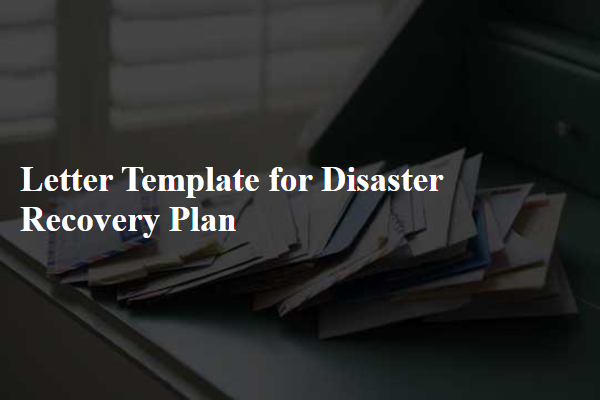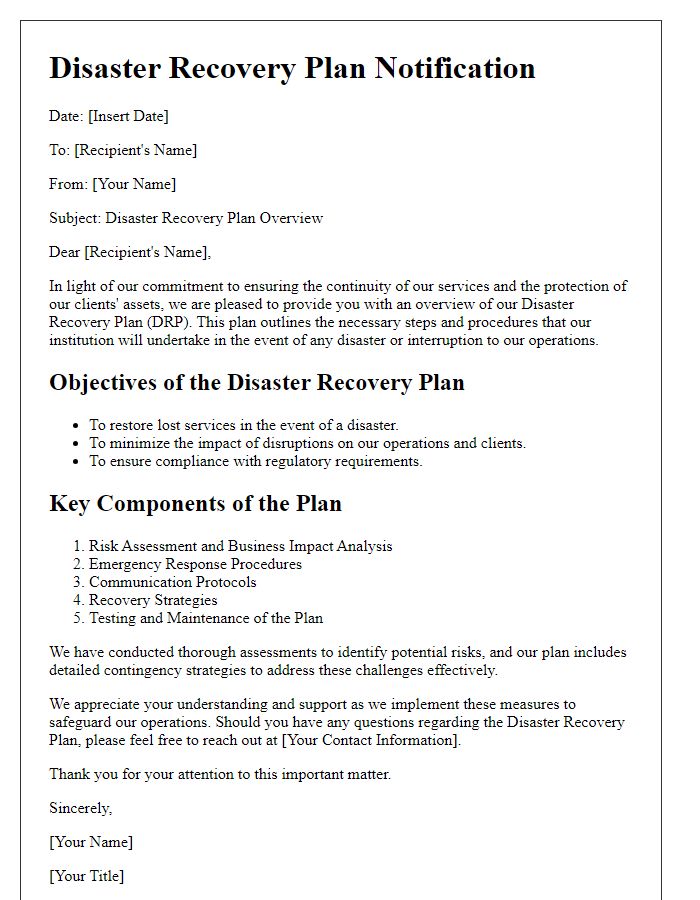In today's world, having a solid disaster recovery plan is essential for safeguarding your organization against unforeseen events. Whether it's a natural disaster, cyberattack, or other crisis, the right plan can mean the difference between chaos and calm. This article will guide you through a practical letter template to communicate your disaster recovery strategy clearly and effectively. So, let's dive in and explore how you can prepare your organization for any eventuality!

Purpose and Scope
A disaster recovery plan (DRP) outlines strategies for maintaining critical functions during unplanned events, such as natural disasters, cyber threats, or system failures. Its primary purpose is to minimize the impact of disruptions on business operations by establishing procedures for restoring IT infrastructure, data integrity, and operational continuity. The scope of this plan encompasses all essential components of the organization, including data centers, employee communication systems, backup protocols, and recovery resources. Key assets identified may include servers, networking equipment, and application software required for day-to-day functions. Additionally, this plan delineates roles and responsibilities for disaster recovery teams, ensuring each member understands their tasks during an emergency response. Regular testing and updating of the DRP are crucial to adapt to changing business needs, technology upgrades, and emerging threats.
Roles and Responsibilities
In a disaster recovery plan, clearly defined roles and responsibilities are critical for ensuring effective response and recovery efforts. The Disaster Recovery Manager oversees the entire recovery process, coordinating all actions and communication with stakeholders. The IT Recovery Team, consisting of specialists in data management and infrastructure, focuses on restoring critical systems and data, ensuring minimal downtime. The Business Continuity Coordinator collaborates with various departments to assess impact and develop strategies for maintaining essential functions during a disaster. Administrative Support provides logistical assistance, helping with documentation and resource allocation. Communication Lead manages information dissemination to employees, clients, and media, ensuring transparency and clarity. Each team member undergoes regular training and simulations to prepare for their specific duties during a crisis, enhancing overall readiness and resilience.
Communication Plan
An effective communication plan is crucial in disaster recovery scenarios, ensuring timely information exchange across all stakeholders. Identification of primary communication channels, such as email (often using services like Microsoft Outlook), SMS alerts, and dedicated crisis hotlines, is essential for swift dissemination of updates. Key personnel, including the Disaster Recovery Manager and department heads, should be clearly defined, with their contact details readily accessible in the organization's emergency response handbook. Regularly scheduled briefings can enhance transparency, while utilizing platforms like Zoom or Microsoft Teams can facilitate remote discussions. The establishment of a communication hierarchy ensures that critical information reaches frontline responders first; this may include assigning a spokesperson to handle media inquiries to uphold brand integrity. Training sessions, conducted quarterly, should familiarize employees with protocols, helping them react proficiently in real-time emergencies, particularly focusing on scenarios like natural disasters (hurricanes, earthquakes) or cyber incidents (ransomware attacks).
Recovery Strategies and Procedures
A comprehensive disaster recovery plan (DRP) outlines essential recovery strategies and procedures for organizations facing disruptive events like natural disasters, cyberattacks, or system failures. Key recovery strategies, such as cold sites (backup locations equipped with essential infrastructure) and hot sites (fully operational facilities ready to take over immediately), ensure business continuity. Additionally, procedures for data backup (regularly saving critical information to secure, offsite locations) play a vital role, with technologies like cloud storage solutions (e.g., Amazon Web Services) and external hard drives for redundancy. Effective communication plans facilitate coordination among team members during emergencies, ensuring swift response actions. Regular testing of recovery procedures through tabletop exercises (simulated scenarios to validate plans) ensures preparedness and highlights areas needing adjustment. Comprehensive documentation of all recovery processes, including contact lists, resource inventories, and timeline expectations, guarantees clarity and efficiency in execution when a disaster strikes.
Testing and Maintenance
A comprehensive disaster recovery plan is essential for organizations to ensure resilience during unforeseen events, such as natural disasters or cyber attacks. Regular testing of this plan, typically conducted biannually, allows for identification of weaknesses and ensures that all employees are familiar with procedures. The involvement of key stakeholders, including IT personnel and management teams, is crucial for effective simulations. Furthermore, maintaining up-to-date documentation, including contact lists, resource inventories, and recovery steps, ensures quick response capabilities. Disaster recovery exercises should take place in designated facilities, ensuring they mirror real-life scenarios. Continuous training sessions enhance employee readiness and awareness, fostering a culture of preparedness across the organization.













Comments